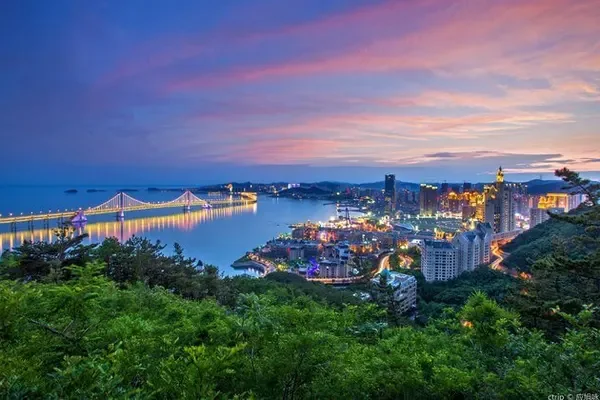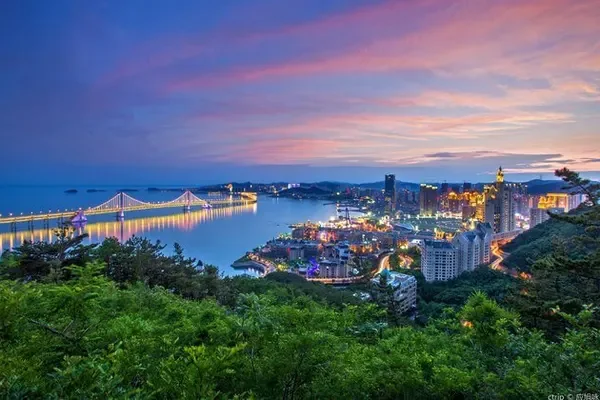When you mention Tongzhou, you may first think of the rising sub-center of the city. Tongzhou is the northern starting point of the Grand Canal. It has both the ancient water transport terminal and the modern Universal Studios. It has a history spanning thousands of years and a collision between ancient and modern times.
The canal is the soul of Tongzhou, inheriting a long history and civilization. Five rivers, Wenyu River, Xiaozhong River, Tonghui River, North Canal and Yunchaojian River, converge here. There are many canal cultural carriers left over to the present, such as the Grand Canal, Yongji Canal, Tonghui River, Empress Dowager Xiao Yunliang River and many other ancient canals, and the history of water transportation has been widely spread.
Traveling is not just about traveling, you can also find beautiful poems and scenery in your own city. Then let us start a two-day, one-night trip to Tongzhou along the historical context of the Grand Canal.
first day:
Burning Lighthouse in Beijing Grand Canal Scenic Area
"A shadow of a tower recognizes Tongzhou", the Lantern Tower in the north area of the Grand Canal Scenic Area in Beijing must have been the most obvious symbol of Tongzhou at that time. This building called the Lantern Buddha Stupa was built in the Southern and Northern Dynasties and has a long history. The brick and wood structure tower is built on the lotus xumizuo, thirteen stories high, with wind chimes swaying, and the Buddha statues on the outer wall are exquisitely shaped and meticulously carved.
The scenic spot has the beauty of the south of the Yangtze River and the atmosphere of the north, and the landscape composed of water, stones, flowers and trees is full of interest. The lake is lush with vegetation, and lotus flowers are in full bloom in summer. From here, you can overlook the ancient pagodas, pavilions, waterside pavilions and burning lighthouses, forming the most beautiful picture.
There is an elm tree called "Tower Elm", which has grown for hundreds of years on the thirteenth floor of the Lantern Tower. It was later transplanted to the lake. Now the new branches are clustered, and the green leaves are lush and lush. There are also many ancient buildings in the scenic area, and the tomb of Li Zhuowu, a master of the Ming Dynasty, is also worth seeing.
Qianhexielu Bridge
Today, the surrounding area of the canal has become a leisurely and relaxing Beijing Grand Canal scenic spot, with beautiful scenery and willows on the water bank. You can take a walk along the river, or take a boat on the canal with an antique painting boat, and you can have a panoramic view of the beautiful scenery of the water transport terminal in those days.
Many bridges span the canal, and the newly promoted Qianhe Xielu Bridge has a unique shape. The white bridge body has beautiful lines and the design of the lotus leaf is cool and beautiful. Many young people who check in are gathered every day.
Tongzhou Museum
As the northern head of the Beijing-Hangzhou Grand Canal, Tongzhou has always been an important place for water transport and a transportation hub, and has preserved extremely rich cultural heritage resources. If you want to systematically understand the history of Tongzhou, you must start from the Tongzhou Museum.
The museum located on the south side of Xinhua Street is a well-preserved two-entry courtyard surrounded by high-rise buildings. Walking along the white marble steps into the small courtyard, it is painted and antique, and the flowers in the small courtyard are in full bloom, and the four seasons are pleasant.
Several exhibition halls show the long and long history of Tongzhou in chronological order with a large number of objects and materials, especially the history of water transportation started in Qin and Han Dynasties and prospered in Yuan, Ming and Qing Dynasties, so that we can fully understand the glory of canal civilization.
Although the area is small, the exhibits are very rich. A large number of precious cultural relics from Tongzhou and the surrounding areas of the Grand Canal have been gathered, from the well-preserved Tongzhou Chronicles, to the unglazed white porcelain carved pots of the Tang Dynasty, and the exquisitely crafted town halls. The green-glazed square pottery vases of the Liao Dynasty, combined with the modern technology of sound and light, each cultural relic records the heavy history of Tongzhou and shows the hard work and wisdom of the people.
Xiaolou Hotel
At noon, I walked into Tongzhou Xiaolou Restaurant. This restaurant has a history of 100 years and is one of the favorite time-honored restaurants of Tongzhou people.
Like the locals, order a signature grilled catfish, crispy on the outside and tender on the inside, with a rich sauce, as if experiencing the canal life a hundred years ago.
zhangjiawan
In the afternoon, drive to Zhangjiawan. Zhangjiawan is not eye-catching now, but when we look at the history of the Grand Canal, from the rise of water transportation in the Yuan Dynasty to the withdrawal from the stage of history in the early 20th century, the small Zhangjiawan was the Grand Canal at that time. The largest wharf, where businesses gather, is famous all over the world.
According to textual research, a small street in the ancient city of Zhangjiawan is the prototype of Shili Street and Huazhi Lane in Dream of Red Mansions. Cao Xueqin, the author of Dream of Red Mansions, once opened a pawnshop here. A statue of Cao Xueqin is erected on the river bank for future generations to admire.
The ancient city of Zhangjiawan now only retains a short section of the ancient city wall. The south gate of the ancient city stands alone by the river, and a stone bridge spans the river to connect the south gate.
The mottled stone slabs on the bridge record the years, and dozens of vivid stone lions are exquisitely carved. Emperor Wanli of the Ming Dynasty named this small bridge Tongyun Bridge, and the locals commonly call it Empress Dowager Xiao Bridge. Although it is now deserted, only some children are playing on the bridge. Who would have thought that ships from the south would stop here, and it was once prosperous.
Chinatown
In the ancient town of Zhangjiawan, Tongzhou, there is a China Tangrenfang Puppet Art Museum, which houses hundreds of traditional Beijing silk figurines known as "Chinese Barbie dolls". These masterworks include vivid and lifelike classic beauties, as well as vivid legendary figures, ranging from ordinary street figures to legends of the Eight Immortals Crossing the Sea. The figures made of raw materials such as gauze and silk have lifelike faces and delicate and soft skin. It is a Tang doll with abundant muscles and beautiful bones for thousands of years.
Now if you want to experience this exquisite skill, you can also experience it in person here. There are more than ten kinds of intangible cultural heritage handicraft courses such as making Tang dolls, batik, embroidery, etc., so that modern people can easily master the profound and profound ancient Chinese traditional art. It is especially suitable for children, entertaining and teaching, and fully understanding and comprehending the charm of China's intangible cultural heritage.
If you are short on time, you can also directly choose a rich variety of Beijing gifts at the Beijing gift store in Chinatown. The Beijing silk figurines that have been used as national gifts many times are different and each has its own story. .
Songzhuang Homestay
There are many B&Bs in Tongzhou, just listening to their names makes people miss each other—"Flower House in the Field", "Small Courtyard on the Canal", "Xiangbei", "Moonlight in the Lotus Pond", "Qingyun Bieyuan"... On both sides of the canal, life is continuous , has long been hidden in the "wish list"
We chose to live in Songzhuang at night, mainly because it is more convenient to visit Songzhuang the next day. Large and small B&Bs are rich and frugal, and we stayed in a B&B "Shun 12" with high cost performance. It is small in scale but ins style The interior and exterior design shows the unique aesthetics of the owner, especially the public areas.
the next day:
Songzhuang
As the northern starting point of the Grand Canal, Tongzhou has a profound historical and cultural heritage, and Songzhuang is the "artistic pearl" of Tongzhou. Songzhuang Art District is often called "Painter Village" by us, and art studios and exhibition halls can be seen everywhere on the streets. Although it is called "Zhuang", the area is actually very large, divided into many different areas.
Since the 1990s, some artists in Beijing began to work and live in Songzhuang. After decades of development, Songzhuang is like a sea containing hundreds of rivers, accepting painters, sculptors, musicians, and all kinds of people from all corners of the country. People who pursue ideals and art settle in, and now there are tens of thousands of artists from all over the country and even the world.
If you come to Songzhuang, you can't miss the exhibition. The three major online celebrity art galleries not only have rich collections, but also are very suitable for filming inside and outside.
Songzhuang Art Museum:
The tall buildings with red brick exterior walls are very eye-catching, and there are some cafes and art shops on the first floor. The white walls and red bricks in the museum are intertwined with light and shadow, which is very impressive. Tickets are free.
Spring Art Museum:
The official name is actually the Museum of Contemporary Art, which is next to the Songzhuang Art Museum. The Mediterranean-style white building is full of exotic customs.
Tree Art Museum:
There are a total of six courtyards, most of which are open to the sky above the building. Therefore, it is also known as the "Paradise Art Museum". The building itself is very photogenic, and it is absolutely perfect to take pictures outside.
Songzhuang has a great reputation, but it still retains a quiet and peaceful atmosphere, far away from the hustle and bustle, without too much commercial atmosphere. In the evening, local residents will enjoy the cool on the street and sell their own fruits and vegetables, which is very down-to-earth. All kinds of literary and artistic shops are scattered in the alleys, and you may find treasures if you just stroll around.
Food is the most exciting part of Songzhuang besides art. From northeast barbecue to Yunnan mushroom pot, from Australian steak to Japanese sushi, it seems that you can find all the cuisines you have heard of here, from the appearance to the environment. Literature and art, it seems that coming here to eat has become an artistic enjoyment.
The two-day, one-night trip to Tongzhou, along the canal to explore the past and the present, can not only touch the relics of the millennium, relive the charm of history, but also experience the elegance and leisure of modern Tongzhou, let go of all the troubles, and spend a relaxing weekend.
If you also have a little persistence and curiosity about history, like to explore those ancient legends, like art, like food, like to enjoy life, then this route is really your dish, a simple itinerary can refer to:
Day1: Burning Lighthouse - Qianhe Xielu Bridge and Canal - Tongzhou Museum - Xiaolou Hotel - Zhangjiawan - Chinatown
Live in Songzhuang B&B
Day2 Songzhuang, Songzhuang Art Museum, Tree Art Museum, etc.
Transportation: The public transportation between the main scenic spots in Tongzhou is convenient. Cycling in the urban area is also a unique experience. In order to save time, it is recommended to drive by yourself.
Tickets: In the above itinerary, except for individual art museums that charge, others are free to visit. Remember to bring your ID card.


